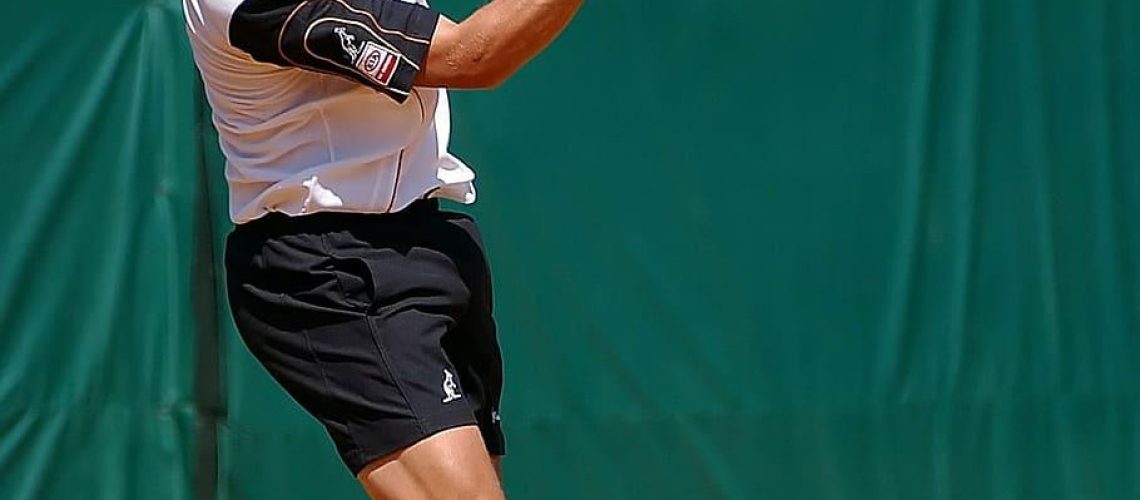We may earn money or products from the companies mentioned in this post.
A Quick Summary

Walkovers are a term used in tennis to refer to a match that has ended without being played due to one player or team failing to show up, withdrawing due to an injury, or being disqualified. Common reasons for walkovers include injuries/illnesses and personal reasons/unforeseen circumstances, and the rules and consequences of walkovers vary depending on the tournament. Penalties for withdrawing from tournaments can include fines, deductions of ranking points, and bans from future events.
The Importance of Understanding the Term “Walkover” in Tennis

Definition of Walkover in Tennis
For those who are not familiar with the sport, a walkover is a term used in tennis to refer to a match that has ended without being played This happens when one player or team fails to show up for the match, withdraws due to an injury, or is disqualified during the game The opposing player or team is then declared the winner by default
Importance of Understanding the Term
While it may seem like a trivial matter, understanding what a walkover means in tennis can have significant implications for players and fans alike For players, it means that they need to be prepared not just physically but mentally as well A last-minute withdrawal from an opponent can throw off their rhythm and concentration, which can affect their performance in future matches
On the other hand, for fans, knowing about walkovers can help them appreciate the effort and dedication that goes into preparing for a tennis match It also adds an element of unpredictability to the sport – you never know when a player might pull out at the last minute or suffer an injury during play
In addition, knowing about walkovers can also provide insight into how rankings are determined in tennis If a top-ranked player receives multiple walkovers due to opponents withdrawing or being disqualified, it could potentially inflate their ranking without necessarily reflecting their true skill level
Conclusion
In conclusion, while it may seem like a minor detail in tennis, understanding what a walkover means and its implications on both players and fans is important Whether you’re new to the sport or a seasoned fan, appreciating every aspect of tennis – including its quirks – can make watching and playing even more enjoyable
| Key Point | Description |
|---|---|
| 1. | Walkovers can affect players’ concentration and rhythm, impacting their performance in future matches. |
| 2. | Knowing about walkovers helps fans appreciate the unpredictability and dedication involved in tennis. |
| 3. | Understanding walkovers provides insight into how rankings can be influenced without reflecting true skill. |
Reasons for a Walkover in Tennis

Player Injury or Illness
A player’s physical condition is one of the most critical factors that can affect their performance on the tennis court Injuries and illnesses are common occurrences in sports, and they can cause players to withdraw from tournaments or matches There are two types of injuries or illnesses that can lead to a walkover in tennis: pre-match injuries/illnesses and mid-match injuries/illnesses
Pre-Match Injuries or Illnesses:
A player may arrive at a tournament with an existing injury or illness that they cannot recover from on time Examples include muscle strains, tendonitis, and viral infections If the injury or illness prevents the player from performing at their best, they may choose to withdraw from the match or receive a walkover
Mid-Match Injuries or Illnesses:
During a match, players may suffer an injury such as sprained ankle, cramps, heatstroke, etc, that hinders their ability to continue playing Similarly, players may also experience sudden illness due to dehydration, food poisoning, etc, which makes it impossible for them to finish the match In such cases too, players usually retire from the match resulting in a walkover win for their opponent
Personal Reasons or Unforeseen Circumstances
Tennis players are human beings first and foremost and like everyone else face unexpected circumstances outside of tennis which can impact their ability to play matches
Family Emergencies:
Personal emergencies like family bereavements, child delivery issues (when male athletes become fathers), hospitalization of close family members etc can cause players to withdraw from matches as they prioritize their family obligations over their professional commitments
Travel Issues or Visa Complications:
Tennis is an international sport, and players frequently travel to different countries to participate in tournaments Sometimes, unforeseen circumstances such as flight cancellations, visa issues, or natural disasters like volcanic eruptions (which have disrupted air travel in the past) may prevent a player from reaching the venue on time or at all In such situations too, players may be forced to withdraw from the tournament or match resulting in a walkover win for their opponent
In conclusion, injuries/illnesses and personal reasons/unforeseen circumstances are two of the most common reasons why tennis players receive walkovers These occurrences may seem unfortunate for fans of tennis who were looking forward to watching their favourite player compete but ultimately player safety and well-being must take priority over any event
| No. | Key Point |
|---|---|
| 1 | Injuries/illnesses as reasons for walkovers |
| 2 | Personal reasons/unforeseen circumstances |
| 3 | Player safety and well-being taking priority |
Walkover Procedures and Consequences in Tennis Tournaments

Tournament Rules and Regulations on Walkovers
When a player is unable to compete in a tennis match due to injury, illness, or other reasons, it results in a walkover The rules and regulations for walkovers vary depending on the tournament However, communication with tournament officials is always necessary to report the situation officially The officials will then make an announcement to spectators and media outlets about the change in schedule
Impact on Players Involved in a Walkover Situation
The impact of a walkover can be significant for both players involved If one player advances to the next round without playing the match, it can provide them with benefits such as extra rest time or avoiding potential injuries from playing another match On the downside, they may lose an opportunity to improve their game or gain experience by not playing
For players who give a walkover, there are ranking points and prize money implications that may affect their future participation considerations Not being able to play due to injury or illness could lead to losing ranking points and missing out on prize money Furthermore, if this becomes a recurring issue, it could negatively affect their overall performance and reputation
The Advancing Player
The player who advances due to their opponent’s withdrawal gets more time for recovery or preparation before their next match – which could increase their chances of winning the tournament It also gives them an opportunity to conserve energy by not playing another match
However, some players prefer not having walkovers as it doesn’t help them get into rhythm during tournaments; furthermore, unexpected rest periods could disrupt momentum built up over previous matches
The Player Giving Walkover
A player giving walkovers faces negative consequences regarding rankings points and prize money awards that usually come with progressing deeper into tournaments Injury concerns could also cast doubt on future participation, given the risk of worsening an existing issue or new injuries
In conclusion, walkovers have consequences for both players involved and tournament organizers While they can be beneficial in some situations, it is essential to prioritize player safety and fair competition Tournament officials must ensure that rules and regulations are followed while taking all necessary steps to communicate changes effectively
| Consequences of Walkovers | Player Involved | Key Points |
|---|---|---|
| Beneficial | Advancing Player | Extra recovery time, conserve energy |
| Negative | Advancing Player | Disrupt momentum, not getting into rhythm |
| Negative | Withdrawing Player | Losing ranking points and prize money, injury concerns |
Variation in Walkovers Across Different Levels and Types of Tournaments

Differences Between Grand Slams, ATP, WTA, ITF, and Other Events
Walkovers are a common occurrence in tennis tournaments where one player withdraws from the match before it begins However, the rules regarding walkovers can vary significantly depending on the level and type of tournament For instance, Grand Slam events have different rules than ATP, WTA, or ITF tournaments
At Grand Slam events such as Wimbledon or the US Open, players who withdraw before their first-round match due to injury receive half of the prize money they would have earned had they played In contrast, if a player withdraws from a non-Grand Slam event like an ATP 500 or WTA Premier tournament before their first-round match, they do not receive any prize money
Furthermore, each event organizer has its own specific set of walkover rules Some organizers may allow players to withdraw after the deadline without facing any penalties while others may impose hefty fines for late withdrawals Additionally, some organizers may allow players to compete in doubles matches even if they withdrew from singles matches due to injuries
Walkover Rules Specific to Event Organizers
While many tournaments follow standard regulations set forth by governing bodies like the International Tennis Federation (ITF), some event organizers implement their own unique rules regarding walkovers For example, some smaller tournaments may allow players to substitute another player into their spot in case of withdrawal while larger events like Grand Slams do not
Moreover, certain events may require players who withdraw after a certain point to provide medical documentation proving that they are unable to play This requirement aims to prevent players from abusing the system by withdrawing for reasons other than genuine injuries
Possible Variation in Ranking Points and Prize Money Penalties
In addition to differences in prize money, walkovers can also affect a player’s ranking points For instance, players who receive a walkover in the first round of a Grand Slam event do not earn any ranking points for that tournament In contrast, players who win their first-round match but withdraw due to injury before their second-round match still receive some ranking points
Similarly, penalties for withdrawing from tournaments can vary depending on the level and type of event While some tournaments impose fines on players who withdraw late or without proper justification, others may penalize players by deducting ranking points or banning them from future events
In conclusion, while walkovers are an inevitable part of tennis tournaments, the rules regarding them can vary significantly between different levels and types of events Understanding these variations is crucial for both players and fans alike to fully comprehend the impact of walkovers on player rankings and prize money earnings
| Key Point | Description |
|---|---|
| Prize Money Penalties | Penalties for withdrawing from tournaments can vary depending on the level and type of event; some events may impose fines, while others may not award any prize money. |
| Ranking Points Deductions | Players who withdraw due to injury or other reasons may face ranking points deductions, which can vary between different types of events. |
| Tournament Bans | In some cases, players who withdraw without proper justification may be banned from participating in future events organized by the same body. |
Useful Links

What is a Walkover in Tennis? Meaning, Rules, Stats …
Uncovering the Meaning of Walkover in Tennis
What is a Walkover in Tennis? Meaning, Rules, Stats, & More
Why has Rafael Nadal pulled out of Wimbledon? And what …
Is a Walkover in Tennis a Push – – The Sports Ground
What does WO mean in tennis? – ingatestonetennis.org.uk
In Tennis What Is A Walkover
The Ultimate Guide to Walkovers in Tennis: Everything You …
What is walkover in tennis? (Things you must know) –
Tennis And Racquet Sports Rules
General Tennis House Rules – PointsBet Sportsbook
What is a walkover in tennis? Rafael Nadal gets …
In Tennis, What Does A Walkover Mean and How … – YouTube
What Is a Walkover In Tennis?
What is a walkover in tennis?
What Is A Walkover In Tennis? (All You Need To Know)
What is a Walkover in Tennis? – TennisLovers
Tennis Retirement Betting Rules【2023】🥇 Walkover Bet
What Is A Tennis Walkover? – Sport-net
Incomplete & Retired Matches






